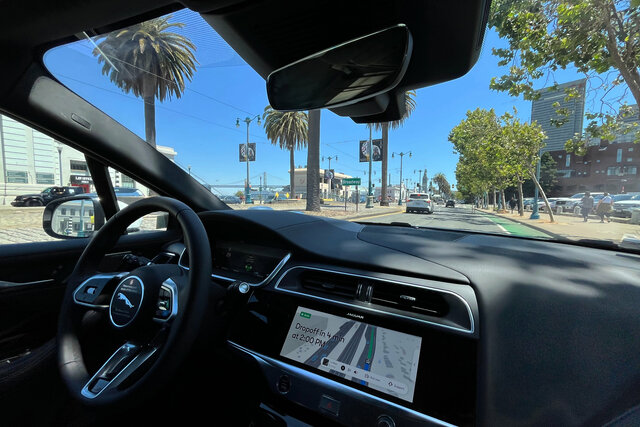Robotaxi
Started: 2024-08-16 11:26:58
Submitted: 2024-08-16 05:12:27
Visibility: World-readable
Riding a Waymo robotaxi in San Francisco
I've seen Waymo cars, mounted with various sensors on every available surface like barnacles, with the lidar dome on the roof spinning like a beanie propeller, on the streets of San Francisco off and on for the past few years. First were humans actively driving the cars for training and mapping; then human safety drivers; and finally a closed list of insiders able to hail driverless rides. Earlier this year, Waymo was operating a wait-list allowing people who signed up to get into a queue to be able to hail rides. In May the Waymo robotaxies were everywhere; I'd see several in the space of a single block. At the end of June, Waymo opened its service to anyone who downloaded the app, which I took as my opportunity to get inside a driverless car.
I finally took the opportunity on the afternoon of Saturday, the 3rd of August. I was in the south-east corner of the Marina, not far from Aquatic Park at the corner of Van Ness and Lombard, and I wanted to get to the Ferry Building to catch a ferry across the bay.
Waymo's app looks like Uber or Lyft, offering a map with one's current location and an interface to pick where to go. It suggested a pick-up location around the corner (where I presume it thought it could find more space) and a drop-off location across the street from the Ferry Building (which turned out to be closer to the ferry gate I wanted anyway). I hit the button to summon a car, and the app said it would take 13 minutes to arrive; until their dispatching algorithm found a closer car and sent that instead. I watched the car approach on the live map, and then spotted it across the street, waiting to cross Lombard Street and then making a u-turn to pick me up on the side of Van Ness Street.
I had to press a button in the app to unlock the car doors (which was somewhat inconvenient, because I was also trying to get myself and my shoulder bag into the car. I hopped into the front passenger seat, and looked over at the driver's seat. This car still had a steering wheel, but it was partially covered by a clear plastic shield (as if it were a museum artifact) and a sign advising me not to touch it. I buckled my seat belt and hit the button on the large touch-screen to start the ride.
The routing algorithm selected a route that took me in a loop around the block to head east towards past Fisherman's Wharf. As we drove the steering wheel turned; I wasn't sure if that was an essential part of the control mechanism or an affectation. It was a little weird to watch the wheel turn to make several sharp turns in a row; and then it kind of felt normal, like a ride at an amusement park.
While we were underway, the touch-screen showed a representation of the driving algorithm's view of the road and our surroundings from its lidar and the rest of its sensor package. Parked cars on the side of the street showed colored in gray. Moving vehicles showed in blue, and people standing and walking on the sidewalk and crosswalks showed as blue dots. When the sensors identified a traffic light or stop sign it marked it on the map.
While I was riding in the car other people stopped and watched (which matches my reaction outside a Waymo when one passes). I was, briefly, a weird sort of celebrity, riding in a driverless car in one of the few places where such a thing exists.
As we drove I paid attention to how the car was driving. It drove like a contentious experienced city driver, less aggressive than most of my Lyft drivers. In places where we were driving through Fisherman's Wharf on a narrow four-lane road with cars parked on the right, the Waymo pulled a bit to the left of the right-hand lane, to give a bit more space for the parked cars. There was one point where a Tesla right in front of us was trying to parallel park and my car stopped to wait for it before pulling into the left lane. The car used its own motion to signal its intent: slowly pulling forward when it was ready to go, and stopping fully when yielding to pedestrians. There were a couple of times when it signaled of a lane change it didn't take, and once when it signaled for a lane change while stopped at a traffic light, then drove straight through the intersection and made the lane change only when it had cleared the intersection.
The routing algorithm took us on what looked like a weird path along the Embarcadero, taking zig-zagging on streets just inland instead of taking the obvious route on the Embarcadero. (Maybe it thought there was more traffic there, or maybe it was avoiding the Embarcadero for some other reason.)
After 17 minutes of driving, covering 2.7 miles by road from the Marina through Fisherman's Wharf and along the Embarcadero, the Waymo drove past the Ferry Building and dropped me off at the curb. Waymo charged me $21.63 for the ride, which seems like it might be enough to cover their operating expenses but will never recover all of the engineering put into building the driverless car and all of the supporting infrastructure. It's an amazing engineering achievement, and I'm excited that I had the chance to experience it in my own robotaxi ride; but I'm not sure it's the right solution for any of the problems we actually face.







